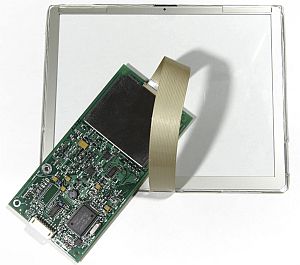 NFI Touch Screen System combines an all glass sensor element and image processing controller with resident firmware, driver software, and a setup and diagnostic utility.
NFI Touch Screen System combines an all glass sensor element and image processing controller with resident firmware, driver software, and a setup and diagnostic utility.
The touch screen sensor is composed of laminated layers of chemically strengthened glass. The base layer is patterned with a conductive sensor and optically bonded to a front layer of tough and durable glass. The sensor is highly transmissive and provides protection against glare and reflections. An AC signal is applied to the patterned conductive coating, creating an electrostatic field on the surface of the screen. When a finger – gloved or ungloved – or other conductive stylus comes into contact with the sensor, the electrostatic field is disturbed. The image processing controller detects the changes in distribution of the electrostatic field caused by a touch. The resident firmware is optimized to provide touch sensitivity, accuracy, and rejection of false touches.
Product Highlights
- Outdoor, harsh environments – Performs consistently and accurately in extreme environmental conditions, including outdoors applications.
- Extreme durability – Operation unaffected by most surface damage, including scratches, caused by abrasives, chemicals or vandalism.
- Ruggedized Shock Resistance – Withstands significant shock and vibration without jeopardizing safety or performance.
- Input Flexibility – Operates with gloves through moisture, dirt and other surface contaminants, as well as with a conductive stylus.
Contributions to the product:
| Conceptualization and Research | Software Development Process |
| Basic touch algorithm enhancements Adaptive base-lining and signal processing Coordinate interpolation and extrapolation algorithms | Overall firmware development process Internal coding standards Development tools selection Version control system Bug tracking system |
| Written Specifications and Procedures | Embedded Software Architecture and Design |
| Hardware requirements and system I/O mapping Functional specification Simulation/emulation environment specification Communication protocol specification | Simulation/emulation design Overall firmware architecture Firmware design documents |
| Code Development | Testing & Debugging |
| Board start-up and boot-loader Device drivers Non-volatile memory management Real-time framework Communication protocol stack Command interpreter | Firmware debug support Exception/error handler Performance analysis tools Diagnostic tools for R&D Touch controller functional tester |
| Technical leadership | Intellectual Property |
| Training and mentorship for the firmware team Design authority and knowledge sharing |
